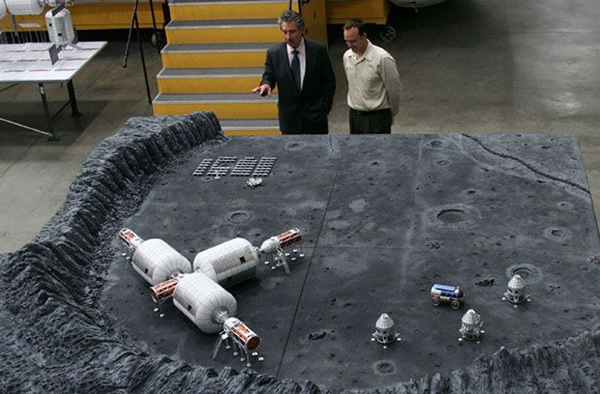Private Firm Sets Sights on First Moon Base
Robert Bigelow discusses a model of a Bigelow Aerospace lunar outpost.
NASA may not be going to the moon anytime soon, but private companies plan to do so, a study by space habitat developer Bigelow Aerospace shows.
The study, commissioned by NASA, is intended as a supplemental roadmap for the U.S. government as it charts human space initiatives beyond the International Space Station, a permanently staffed research complex that orbits about 250 miles above Earth.
“Instead of being the typical approach where we put together all the plans and we ask for participation, we wanted to look at it the other way and see what’s available,” NASA’s head of space operations, Bill Gerstenmaier, told reporters during a press conference on Thursday.
“This is a holistic kind of effort,” added Robert Bigelow, president and founder of the Nevada-based firm that bears his name. “It’s intended to encompass as much (information) as possible and it’s intended to evolve and to grow.”
The first part of the study surveyed about two dozen companies and research organizations about their ideas, plans, capabilities, schedules and costs for upcoming space initiatives. A draft report was submitted to NASA on Thursday -- 40 days ahead of schedule -- and has not yet been publicly released.
NASA intends to use the information to figure out where it can collaborate with private space initiatives and where it might, for example, entirely skip an expensive research and development program and just buy services or hardware commercially.
For example, after the International Space Station is removed from orbit, NASA could be a tenant aboard a Bigelow Aerospace-owned habitat for any microgravity research or technology development it wants to do.
“We think station can fly to 2028,” Gerstenmaier said.
After that, “we won’t be in the business of maintaining and operating a facility in low-Earth orbit. We believe that there will be a service available for us and the private sector,” he said.
NASA plans to follow the space station program with human missions to an asteroid by 2025 and to Mars about a decade later. The most recent version of its exploration blueprint calls for a robotic mission to retrieve a small asteroid and relocate it into orbit around the moon. Astronauts then would launch for a scientific sortie.
By that time, NASA may find it has neighbors on the lunar surface.
“The brass ring for us is having a lunar base,” Bigelow said. “That is a desire we’ve had for a long, long time.”
"I think that’s perfectly acceptable," added Gerstenmaier. "NASA and the government focus on maybe deep space, we focus on asteroids. The private sector picks up the lunar activity and then we’ll combine and share with them to see what makes sense."
"This gives us a chance to step back and do a bigger view of our planning and not doing it in our own little stovepipes. We’re actually reaching out and starting to look right at the beginning as we start to formulate our thinking,” he added.
NASA expects to release the first part of Bigelow's study within a few weeks. The second section is expected to be finished this fall.(May 24, 2013 11:52 AM ET // by Irene Klotz)












